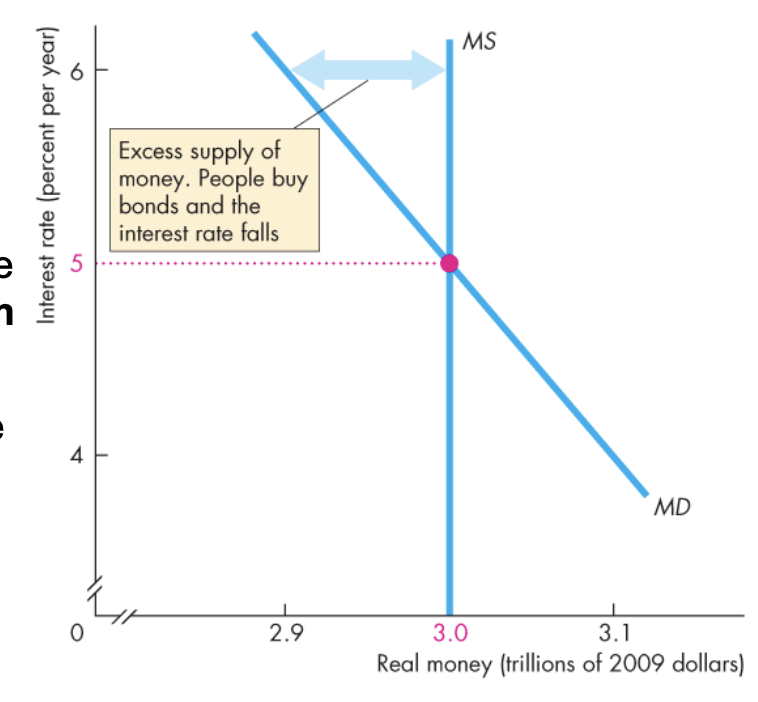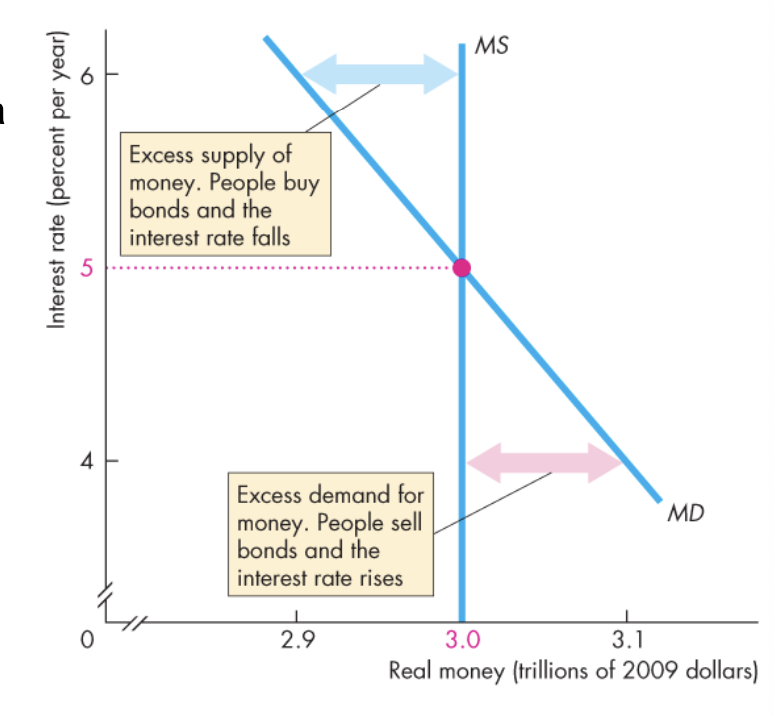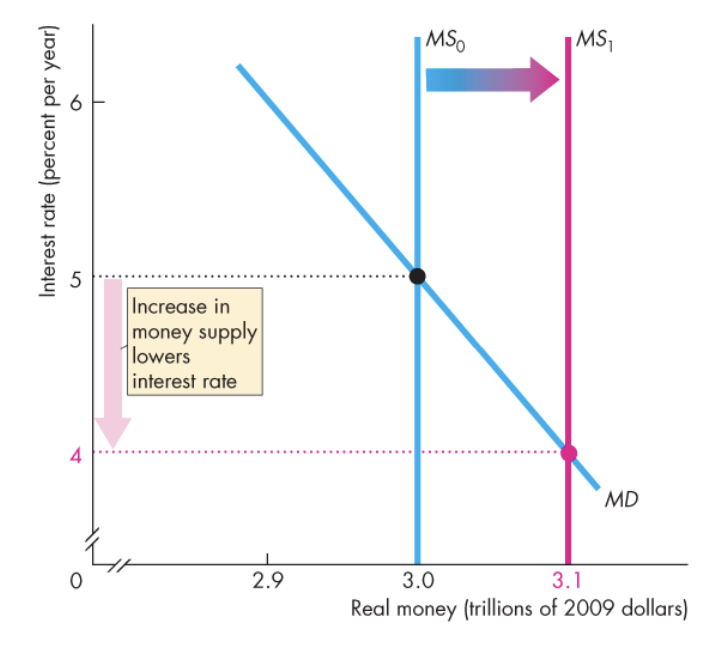Macreconomics: Chapter 8 The Money Market
1/31
There's no tags or description
Looks like no tags are added yet.
Name | Mastery | Learn | Test | Matching | Spaced |
|---|
No study sessions yet.
32 Terms
Money market
virtual market in which households/businesses demand money, the Fed/Banks supply money, equilibrium quantity of money and interest rate are determined
Demand for money
the relationship between quantity of real money demanded and nominal interest rate, when all other influences remain the same
Quantity of money demanded depends on
nominal interest rate forgone by not holding an interest earning asset like bonds and savings accounts
People can either have money or bonds that pay them (example)
the nominal interest rate (not the real interest rate)
4 main factors the quantity of money people hold is dependent on
Nominal interest rate, the price level, real gdp, financial innovation
Nominal interest rate
movements along the demand curve
if nominal interest rate rises
the quantity of real money demanded decreases (higher incentive to hold bonds, which earn higher interest rate than holding money)
If nominal interest rate falls
the quantity of real money demanded increases (higher incentive to hold more rather than bonds, which earn low interest)
Rise in the price level
increases the quantity of nominal money, does not change quantity of real money that people plan to hold
real money =
nominal money / price level —→ adjusts for inflation
Nominal money =
amount of money measured in dollars —> doesn’t adjust for inflation
10% rise in price level leads to
increases quantity of nominal money demanded by 10% (it’s a movement)
Real GDP
quantity of money that households and firms plan to hold depends on the total amount they are spending
increase in real GDp
increases aggregate expenditure (total spending) and increases the demand for money (shift)
Financial innovation
Lowers cost of switching between money and interest-earning assets, people are less likely to hold large amount of cash because they can quickly acess savings acconts or other interest-bearing accounts, decreases demand for money (shift)
A decrease in real GDP or financial innovation
decreases demand for money, shifts demand curve left
increase in real GDP
increases demand for money, shifts demand curve right
Supply of money
relationship between the quantity of money supplied and the nominal interest when all other influences on the amount of money that Fed and banks wish to create remain the same
money supply curve is
vertical and controlled by the Fed through Open Market Operations
Adjustments that occur to money market market equilibrium
are different in the short run and long run

If the Interest rate is 6% a year:
the quantity of money demanded that people are willing to hold is less than quantity supplied, people try to get rid of excess money by buying bonds, this actions lowers the interest rate

If the interest rate is 4% a year, then:
Quantity of money demanded exceeds quantity supplied, people try to get more money by selling bonds, this action raises the interest rate

Short run effect of change in quantity of money and MS to the right
Fed increases the supply of money, given surplus of money, people use excess cash to buy bonds, increased demand for bonds raises the bond price and lowers the interest rate
MS Shifts left
Fed decreases the quantity of money, shortage of money, people sell bonds, increased supply of bonds lowers bond price and raises interest rate
In the long run, the loanble fundsd
determines the real interest rate
In the long run, nominal interest rate equals
the equilibrium real interest rate plus the expected inflation rate
In the long run, real GDP equals
potential GDP, so the only variable left to adjust in the long run is the price level
If in long run equilibrium, the Fed increases the quantity of money
the price level changes to move the money market to a new long-run equilibrium
in the long run, nothing real
has changed
Unchanged factors in the long run
Real GDP, employment, quantity of real money, and the real interest rate
In the long run, the price levels rises
by the same percentage as the increase in the quantity of money
Transition from short run to long run
start in full employment equilibrium, if fed increases quantity of money by 10 percent nominal interest rate falls, as people buy bonds the real interest falls, as the real interest rate falls consumption and investment increases so aggregate demand increases, with the economy at full employment the price level rises, as the price level rises the quantity of real money decreases, the nominal interest rate and the real interest rate rise, as the real interest rises expenditure plans are cut back and eventually the original full-employment equilibrium is restored, in the new long run equilibirum the price level has rise 10 percent but nothing real has changed